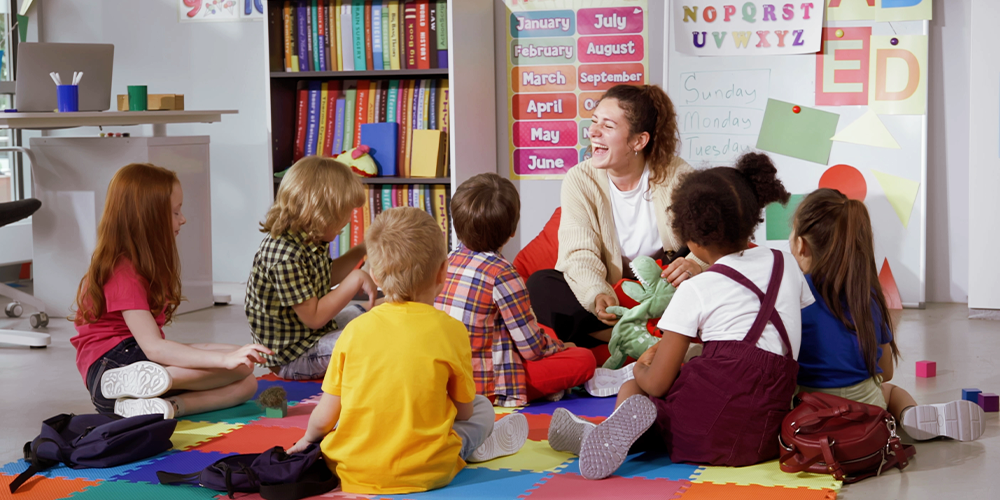Phonemic awareness is an important skill that prepares students for early literacy. It’s one of the first steps on the journey towards confident and accurate reading. In fact, many experts consider it a powerful predictor of reading success! The National Reading Panel Report showed that for students of all abilities, teaching phonemic awareness leads to improved reading, and that it’s most effective when students are explicitly and systematically taught to manipulate phonemes with letters.
What is phonemic awareness?Phonemic awareness is the ability to identify, say, and manipulate the smallest sounds in words—the phonemes. For example, sheep has three sounds or phonemes /sh/ /ē/ /p/. Phonemes are represented in the written language by graphemes. Graphemes can be individual letters or groups of letters that represent single sounds. The graphemes in sheep are: sh, ee, and p. |
Ready to incorporate phonemic awareness into your jam-packed day? Fear not! The oral language games outlined below offer students a chance to hone their skills and reinforce their learning through repetition. We encourage you to insert practice throughout the day, such as when lining up, transitioning between activities, or during a circle game. Here are 10 engaging, multisensory activities designed to make phonemic awareness a fun and integral part of your teaching repertoire:
Develop Phonemic Awareness
Guess Who?
Have students guess the name of other classmates using initial sounds. Secretly choose a name and enunciate its initial phoneme only. For names beginning with a stop consonant, such as David, repeat the phoneme over and over, clearly and distinctly: “/d/ /d/ /d/ /d/ /d/.” Stretch and repeat any continuant consonants (“/s-s-s-s/ /s-s-s-s/ /s-s-s-s/”). If more than one child’s name has the same initial sound, you can encourage children to guess all of the possibilities.
Treasure Box
Send students on a treasure hunt around the room looking for objects starting with a particular sound, saying the sound aloud as they look (alternatively you can provide students with a set of picture cards). When they have found something they think starts with the sound, they place it in a treasure box. With the teacher, they decide if each object begins with the appropriate sound and should stay in the treasure box.
Practice Phonemic Isolation
Silly Words
Give students a sound and have them replace the sound at the beginning of their names. Say, “The silly sound is /b/. Change the first sound in your name to /b/,” such that Jessica becomes Bessica and Cole becomes Bole. You can do this with names and other words.
Two and Three-Sound Words
Hand each student three beads, pennies, LEGO bricks, or other objects. Ask them to show you how many sounds a particular word has. For example, top has 3 sounds (/t/ /o/ /p/), so students would place three objects in a row. Next, have them tap each object as they say the sound.
Practice Oral Blending
Putting it Together
Say a word stretched out with every phoneme separated by a pause. Have students repeat the word back to you as a whole unit. For example, when you say, “/b/…/a/…/ck/,” the students respond, “back!”
Sit Down/Stand Up
Start with all the students standing up and say, “Sit down if you are wearing /g/ /r/ /ee/ /n/. Those wearing green sit down and say the blended word together, “green.” Repeat with other colors, characteristics, likes/dislikes, etc. Continue until all of the students are sitting or play the game in reverse (“Stand up if…”).
Practice Oral Segmentation
Word Chop
Give students words to segment using a karate chop motion in between each sound. For example, say “hat,” and students say /h/ (chop) /a/ (chop) /t/ (chop). Be sure to spend time reviewing expectations for personal space and safety before starting this activity!
Secret Sound
Explain to students that you’re going to play a word game. You’ll say three words and they tell you what sound they hear in all the words. For example if you say seat, meet, sheet, students should respond with /ē/. Just be sure the target sound is in the same position in all words– initial, medial, or final.
Phoneme Manipulation
Spot the New Phoneme
Explain that students will work to spot the sounds that have “snuck” into a word to create a new word. You can use this list (p. 4) to gather pairs of words, like “nail” and “snail” or “for” and “fort.” Students will then identify what sound was added to the second word and for additional challenge, the position where it was added (initial, medial, or final). You can modify this activity to practice phoneme deletion (What’s Missing) and substitution (Spot the Swap).
Sound Switch
Tell students that you are going to say a word and they will reply with the same word minus the first or initial sound in the word. Example: “I am going to say dog without the initial sound– /og/. Now it’s your turn.”
Phonemic awareness in your daily teaching routine is not just a beneficial addition but a transformative step toward fostering skilled reading in your students. These activities not only make learning fun but also reinforce the crucial foundation for early literacy.
Our newest course, 5282: Systematic and Explicit Phonics Instruction for Early Reading and Writing Success provides an opportunity for educators to gain in-depth understanding of the processes and science behind learning to read. You’ll explore the foundational underpinnings of phonics—the alphabetic principle, phonemic awareness, letter-sound correspondence, spelling patterns, and more advanced phonics skills like syllable division and morphology.
Perfect for general educators, interventionists, support specialists and special educators, this transformative course ensures you’re better equipped to address student errors with explicit and targeted instruction so that students come away with a strong foundation for future reading success!






